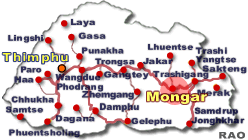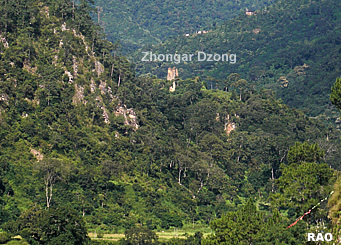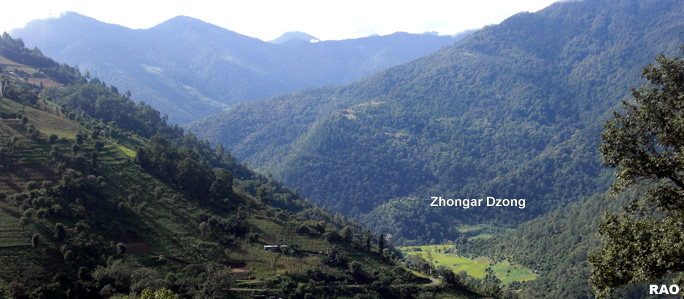 |
Bhutan's
Culture Dzongs |
|
 |
Bhutan Information |
|
|
|
 |
|
Oral
accounts of Zhongar Dzong
|
 |
 |
| The
ruin of Zhongar Dzong is a familiar sight on the Thimphu-Trashigang highway
between Lingmithang and Thidangbi village in Mongar. The ruin of
this magnificent monument opposite the highway still imposes its presence
even a few centuries after it was abandoned.
In
the absence of any written record, a story about the dzong and history
surrounding it can be reconstructed only through oral sources which are
also scanty. The local people believe that Gyalpo Karpodhung invited
its chief architect Bala from Paro. |
|
Evidence of his journey to Zhongar
can be found in several places between Ura and Zhongar.
On
reaching Saleng, Bala made a visual survey of the place. He reportedly
saw a white stone bowl on a small hill and decided to build a new dzong
on it. He named it Zhongkar (gzhong dkar), meaning white bowl
(gzhong = bowl, dkar = white). But down the centuries, the place came
to be known as Zhongar. Another source claims that when Bala neared
Lingmithang, he had a vision of a hill marked by a natural rock similar
to a gzhong, a wooden bowl used as an eating utensil.
|
The
Utse of the Dzong is still intact
|
 |
 |
Fearing
that the new dzong might intrude into his territory, the tsen of Golongdraksent two junior tsen to kill Bala before reaching the place. The two tsen
hid in the jungle and waited for Bala. But Bala never came. They instead
saw a 'wooden-cross' moving along the road. It was later found out that
the 'wooden-cross' was Bala's lopen (carpenter's measuring scale). Even
today it is believed that a carpenter should always carry his lopen to
avoid any harm. |
After
arriving in Zhongar, Bala surprisingly disappeared for seven days. Later
he was found in Jangdhung where he had made a model of his new dzong from
artemesia stems. Bala built the dzong based on this model. It was said
that there were no rough edges in the structure and not a single rock that
was out of place.
The
Dzong consisted of four main structures:
 |
Dratuel
Dzong (dgra btul rdzong) to the east |
 |
Chhudzong
Tsenkhar (chu rdzong btsan khar) to the south |
 |
Bjachung
Ta Dzong (bya chung ta rdzong) to the west |
 |
Dhumrey
Sipki Dzong (ldum ras rtsig pa kyi rdzong) to the north |
|
The Dzong's
courtyard was so long that it was used as an archery range. But the
king began to worry that Bala might build another dzong of greater wonder.
So on the eve of Bala's journey back to Paro, the king cut off his right
hand during chelchang (departure drink) arranged at Zhugthri.
top
|
The
legend of the Dzong
|
 |
 |
| In
agonizing pain Bala prayed that the king must also die in pain, and that
when he (Bala) was dead, he should be born as a demon (bdud) of the Dzong and surrounding lands. Local people believe that Bala was
born as a giant snake which still guards the ruin of the Dzong. Later a
snake started killing the king's horses. One version narrates that it was
the Golongdrak tsen which killed one horse every night. The king then invited
the Peseling Trulku Tenpai Gyaltshen from Bumthangto perform a
religious ceremony. |
|
The trulku stopped above Saleng and started to blow
his conch, the sound of which was said to have cured one of the king's
dying horses.
The trulku entered
into a retreat in the citadel of Golongdrak tsen with instruction that
he should not be disturbed for seven days. But the king grew suspicious
of the trulku's intent and lost faith. On the sixth day he sent his chamberlain
(gdzimdpon) to spy on the trulku. The chamberlain saw a gigantic snake
prostrating before the trulku.
The trulku came out after the seventh day
to inform that the tsen had not been completely subdued because of the
king's distrust of him and the chamberlain's disturbance. The king offered
a hundred cows and pasturelands around Yundhiridrang in repentance. Even
today, Peseling Trulku owns the same pasturelands. The trulku then consecrated
the Dzong and Kurizampa.
|
Prominent
dzongpons
|
 |
The
Dzong's nangten were offered by Lama Sherab Jungney of Khengkhar,
while Lama Sangay Zangpo of Kilikharmade the altar. Though the
two lamas never met, statues fitted exactly into the altar. The kanjur
was copied in Fire-Male-Dog-Year of 11th rabjung (sexagenary cycle) in
1646 when Ngawang Penjor was the Dzongpon. It took 108 clerks about six
months to copy it. Ngedup Penjor was the master of letters or alphabets
(yigdpon), while Ngawang Pekar supervised overall work.
During
the rivalry between Gyalpo Karpodhung and Gyalpo Tongden of Tongfu,
the former sought Trongsa Penlop's assistance. The forces of Trongsa
Penlop defeated the Tongfu Gyalpo and surprisingly took control of the
Zhongar Dzong and other kingdoms. It was at that time that people of neighbouring
Ngatshang and Themnagbi villages migrated, fearing the new ruler, to Pema
Ked (padma bkod)- a legendary hidden land (sbas yul) in south-east
Tibet.
Some prominent Zhongar dzongpons after Gyalpo Karpodhung were Chaskarpa, Kologpa, Naamedla (Hap Shaw), Jampel from Dungsam, Darpoen Choki
Gyeltshen, Ten Samdrup, Ngawang Penjor, Dorji Penjor, Kinzang Wangdi and Lopen Tashi.
top
|
Damaged
by fire and earthquake |
 |
 |
| Centuries
later the Dzong was damaged by a disastrous fire. Later it was destroyed
by a supernatural earthquake lasting for seven days. The number seven has
been considered significant in the dzong's history. First, its builder
Bala took seven days to make the dzong's model out of artemesia stems.
Second, Peseling Trulku meditated for seven days to subdue the Golongdrak
tsen, and finally an earthquake that destroyed it lasted for seven days. |
|
The
earthquake was a blessing in disguise since most people favoured abandoning
the place which was believed to be infested with demons and malaria. the
zingarp sent by Trongsa Penlop to assess the damage was bribed to report
falsely that the Dzong cannot be repaired. Thereafter, it was abandoned,
and its functions shifted to present Mongar.
|
Fearing
the snake |
 |
To
local people the place is shrouded in fear. Stories of the presence of
certain malevolent spirits and a gigantic snake guarding a treasure of
gold and silver are only whispered.To most of us, the ruin is not even
worth taking notice. Beyond a pile of stones and mud, it echoes past life
to connect us to the future. Embedded inside is a life frozen in time,
a wealth of history that can be still recounted orally by those who also
heard itfrom their grandparents.
| Source: Centre
for Bhutan Studies |
 |
top
| Information on Bhutan |
 |
|








